|
Bathyscaphe Trieste, latter on US Navy’s DSV-I
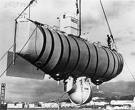 Auguste Piccard`s first bathyscaph, the FNRS-2, was referred to as the "submarine balloon" because its heavy-metal ballast, attached by electromagnets, allowed it to sink to a desired depth when engaged and rise to the surface when released. It had greater maneuverability than the Bathysphere, though it did not well in tests. Piccard and his son Jacques later designed and built a new bathyscaph, the Trieste. Auguste Piccard`s first bathyscaph, the FNRS-2, was referred to as the "submarine balloon" because its heavy-metal ballast, attached by electromagnets, allowed it to sink to a desired depth when engaged and rise to the surface when released. It had greater maneuverability than the Bathysphere, though it did not well in tests. Piccard and his son Jacques later designed and built a new bathyscaph, the Trieste.
The bathyscaphe ("bathy" = deep, "scaphe" = ship) Trieste was built in 1953 at Naples, Italy, by the Swiss scientist Auguste Piccard and his son Jacques. The Trieste, essentially a steel sphere attached to large float filled with aviation petrol for buoyancy, lacked manipulators, or samplers, and it was quite large and not very maneuverable. But it allowed unprecedented observations from the water surface down to the benthos (organisms that live on or in the ocean bottom) and provided a tantalizing glimpse of future discoveries.
 After several years of operations in the Mediterranean, she was purchased by the US Navy in 1958, under the sponsorship of Office of Naval Research. Transported to San Diego CA she conducted tests in the Pacific during the next several years. In October 1959, after being fitted with a stronger pressure sphere, Trieste was transported to the mid-Pacific to participate in Project "Nekton", in which she conducted a series of very deep dives in the Marianas Trench. After several years of operations in the Mediterranean, she was purchased by the US Navy in 1958, under the sponsorship of Office of Naval Research. Transported to San Diego CA she conducted tests in the Pacific during the next several years. In October 1959, after being fitted with a stronger pressure sphere, Trieste was transported to the mid-Pacific to participate in Project "Nekton", in which she conducted a series of very deep dives in the Marianas Trench.
On 27 January 1960 the Trieste took two men, Lt. Don Walsh US Navy and Jacques Piccard, to a depth of 35,800ft (10,910 meters), the deepest spot in the ocean, in the Mariana Trench near Guam. It took 5 hours to fall 7 miles, and when the explorers reached the bottom they stayed 20 minutes. No one has been able to come near that depth since then. At this depth, the pressure is over 8 tons per square inch (some 1,000atm). In 1963, she went to the Atlantic to search for the lost submarine USS Thresher (SSN-593). In August 1963, Trieste found Thresher`s remains off New England, 1400 fathoms below the surface. The bathyscaphe was retired soon after that, and some of her components were used in the newly constructed Trieste II (DSV-1).
Trieste II is currently on display at the Keyport Submarine Museum, Washington, USA.
The Trieste II, DSV-1, submersible
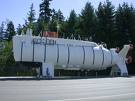 In March 1965, with a new float assembly installed the redesignated Trieste II submersible was developed. The new mission specified (in its second form) was testing and evaluating deep submergence concepts, equipment and sensors. After many successful dives, Trieste II submersible was taken into dry-dock and overhauled into yet another configuration. Designated the Trieste II (DSV-1) it was certified to dive to 12,500 feet. The Trieste II has seen many changes and modifications since its overhaul in 1970. Different scientific equipment was added and removed with each individual dive depending the dive mission. Throughout its transforming life, The Trieste submersible was one the most significant deep submergence submersible vehicles ever created both in the eyes of undersea technology and research. In March 1965, with a new float assembly installed the redesignated Trieste II submersible was developed. The new mission specified (in its second form) was testing and evaluating deep submergence concepts, equipment and sensors. After many successful dives, Trieste II submersible was taken into dry-dock and overhauled into yet another configuration. Designated the Trieste II (DSV-1) it was certified to dive to 12,500 feet. The Trieste II has seen many changes and modifications since its overhaul in 1970. Different scientific equipment was added and removed with each individual dive depending the dive mission. Throughout its transforming life, The Trieste submersible was one the most significant deep submergence submersible vehicles ever created both in the eyes of undersea technology and research.
Technical specifications, Trieste-II:
Displacement (srf/sub tons): un known/305
Dimensions (L*B*D feet): 78`0*16`0*21`0
Propulsion:battery operatedelectric motors, 1*main motor with one propeller, 2*external motors
Speed (srf/sub knots): un known
Range (sub n/miles@knots): 24@2
Diving depth (feet): 20,000 (6,300m)
Complement: 3 crew members
Back to History Index
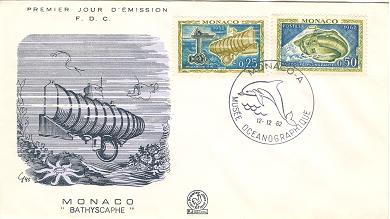 |
Monaco |
1962 |
Bathyscaphe Trieste and Williamson's Photosphere 1914, 12 Dec' 1962 |
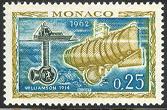 |
Monaco |
1962 |
Bathyscaphe Trieste and Williamson`s Photosphere 1914 |
 |
San Marino |
1983 |
Bathyscaphe Trieste (-10,916 m') 23.01.1960 and Auguste Piccard 1884-1962 |
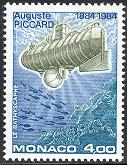 |
Monaco |
1984 |
Auguste Piccard 1884-1984.Bathyscaphe Trieste |
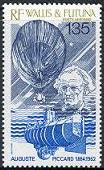 |
Wallis & Futuna |
1987 |
August Piccard (1884-1962) bathyscaphe Trieste and stratospheric balloon |
 |
Switzerland |
1994 |
Bathyscaphe Trieste (-10,916 m') 23.01.1960 and Auguste Piccard 1884-1962 |
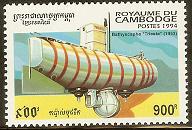 |
Cambodia |
1994 |
Bathyscaphe Trieste 1953 |
 |
Palau |
1995 |
Trieste 35,800 feet |
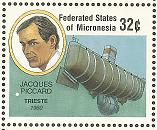 |
Micronesia |
1997 |
Jacques Piccard, Bathyscaphe Trieste 1960 |
 |
Palau |
2000 |
Trieste, 1960 J. Piccard and Lt. Don Walsh dive to a record of 35,800 feet |
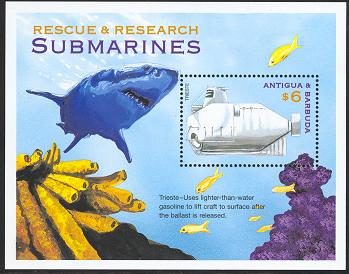 |
Antigua & Barbuda |
2000 |
Rescue & Research submarine. Bathyscaphe Trieste (souvenir sheet) |
|